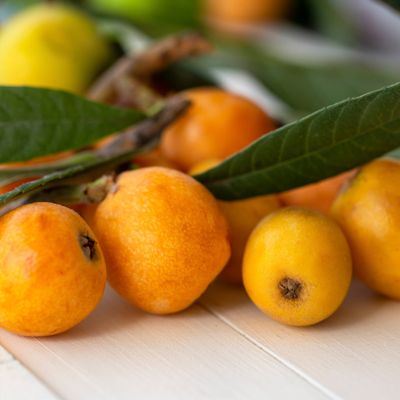Loquat Tree
Description
About Loquat Trees
The Loquat Tree (Eriobotrya japonica), also known as the Japanese plum tree, is a hardy, evergreen fruit tree that produces sweet, tangy loquats in the spring and early summer. Native to southeastern China, loquats belong to the Rosaceae family, making them relatives of apples, pears, and cherries. Their oval-shaped, yellow to orange fruit is packed with natural sweetness, acidity, and pectin, making them perfect for fresh eating, homemade jams, jellies, and desserts.
Why Grow a Loquat Tree?
- Produces delicious, nutrient-rich fruit in spring
- Disease-resistant and easy to grow
- Cold-hardy in USDA zones 7-10
- Low-maintenance with glossy, ornamental foliage
- Attracts pollinators and wildlife to your garden
- Loquat leaves are highly valued for tea and herbal remedies
Loquat Leaves – A Hidden Gem for Herbal and Wellness Uses
Beyond the delicious fruit, the loquat tree’s leaves have been used in traditional herbal medicine for centuries. Loquat leaves (nispero leaves) are rich in antioxidants, triterpenes, and flavonoids, making them popular for wellness teas, extracts, and natural remedies.
Health Benefits of Loquat Leaves
- Loquat Leaf Tea – Brew fresh or dried leaves into a soothing tea believed to support:
- Respiratory health – Used in herbal traditions for soothing coughs and congestion
- Blood sugar regulation – Studies suggest loquat leaves may help support balanced glucose levels
- Digestive support – Known for aiding gut health and digestion
- Skin health – Often used in skincare products for its anti-inflammatory properties
How to Use Loquat Leaves
- Fresh or dried leaves can be steeped into loquat leaf tea
- Loquat leaf extract is used in herbal remedies and supplements
- Crushed loquat leaves are sometimes applied topically in skincare
By growing a Loquat Tree, you’ll not only enjoy its sweet fruit but also gain access to nutrient-rich loquat leaves, a valuable addition to home herbal remedies.
Choosing the Right Loquat Tree for Your Garden
Zone Compatibility
Your climate plays an important role in whether a loquat tree will produce fruit or even survive. Loquat trees prefer warmer climates and grow best in USDA zones 7-10. Before ordering, be sure that your location falls within the recommended loquat tree growing zones.
Mature Tree Size
Make sure you pick the right size tree for your space. When fully grown, our loquat trees reach 20-30 feet tall with a rounded, open canopy and dark green, glossy leaves that add beauty to any landscape.
Growing Requirements
- Thrives in well-drained soil (loamy, sandy, or clay-based)
- Drought-tolerant and wind-resistant
- Requires full sun for best fruit production
- Pollinated by bees and attracts butterflies and beneficial insects
- Highly resistant to most fruit tree diseases, though occasional fire blight may occur
Harvesting and Uses
The fruit is ready to harvest when its skin turns yellow or deep orange. Loquats do not ripen well off the tree, so it’s best to wait until fully mature before picking. Their flesh can be white, yellow, or orange, offering a sweet yet slightly tangy taste.
Ways to Enjoy Loquats
- Eat fresh – Peel and enjoy as a juicy, refreshing snack
- Freeze whole for smoothies or later use
- Make homemade jellies, jams, cobblers, and preserves
- Brew loquat leaf tea using the tree’s nutrient-rich leaves
Ornamental and Wildlife Benefits
Beyond its fruit production, the Loquat Tree is a stunning landscape tree that provides year-round greenery and attracts pollinators like bees and butterflies. Its fragrant white blossoms add beauty to gardens, while the fruit offers a natural food source for birds and other wildlife.
Characteristics
| Bloom Color | White |
| Fruit Color | Orange |
| Fruit Size | Small |
| Hardiness Zone Range | 7A - 10 |
| Pollination | Pollinator Required |
| Shade/Sun | Full Sun |
| Soil Composition | Loamy |
| Soil Moisture | Well Drained |
| Soil pH Level | 5.5 - 6.5 |
| Taste | Subacid, Sweet |
| Years to Bear | 3 - 5 |
Size & Spacing
Mature Size
Recommended Spacing
Zone Compatibility
Pollination
This variety requires another one for adequate pollination.
Tools & Supplies
Planting & Care
Learn all about how to grow loquat trees in The Growing Guide. An entire section of our website dedicated to your growing success.
Shipping Information
Estimated Delivery Date
Arrives when it's time to plant
Questions & Answers
Customer Reviews
More items we think you'll love!
 On Sale
This variety is compatible with your location
On Sale
This variety is compatible with your location
 This variety is compatible with your location
This variety is compatible with your location
 On Sale
This variety is compatible with your location
On Sale
This variety is compatible with your location
 On Sale
This variety is compatible with your location
On Sale
This variety is compatible with your location
 On Sale
This variety is compatible with your location
On Sale
This variety is compatible with your location
 On Sale
This variety is compatible with your location
On Sale
This variety is compatible with your location




